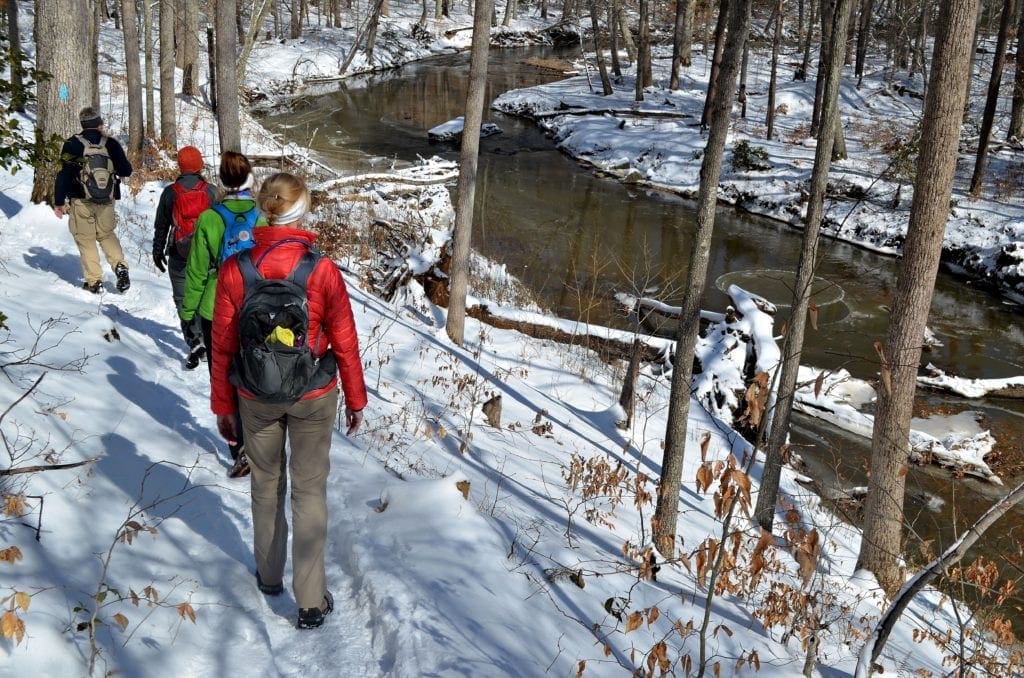In the summer of 2014, I moved to Richmond. It was after I had made this decision to move that the Sevenoaks Board made the move to hire a fulltime center manager. I went ahead and threw my hat in the ring, but didn’t get picked. The decision was made to hire a person who was unfamiliar with the Pathwork.
By now, I was pretty well versed in how transference worked, and I knew it when I saw it in action. I also know how sour grapes work. I love my son Charlie’s take:
Sour Grapes by Charles Sanders, circa 2002 (~age 9)
“If I were a fruit, I would be a sour grape. I would be a sour grape so nobody would eat me. I want to live a long time. I would be happy if I was sour.”
That was a painful experience for me, but hanging onto a cluster of crap is not the Pathwork way. Not long after that, I resigned from the Mid-Atlantic Pathwork Board. Then I literally went for a hike.

Virginia is a gorgeous state and I got to see a lot of it on foot. Because for the next year, I would hike once or twice a week, racking up 600 miles with a group called the Master Hikers. I actually over-hiked my tootsies, developing swollen tendons in the balls of my feet, known as Morton’s Neuroma, which significantly slowed my roll.
The solution was custom-made inserts for my shoes that would relieve the pressure on the balls of my feet. Technically, they are called “orthotics” but I prefer “inserts” because to my ear, nothing screams old age louder than Now wearing orthotic shoes! My days of youth, I realized, were past.
Speaking of the past, my Scandinavian heritage was implicated a year later, while living in DC, when I noticed a strange little lump in the palm of my left hand. When it hadn’t gone away after a few months, I went to a doctor to have it checked out. Hand X-rays done, the doctor walked into the exam room and after a few pleasantries asked me where I was from. The cascade of possible answers in my mind was long.
Finally I asked, “Like originally?” He nodded.
“Norway,” I answered.
“Yep, thought so. You’ve got something called Dupuytren’s Contracture and it’s genetic.”
It’s also known as Viking disease. It’s a thickening and shortening of the fibrous tissue inside the palms, and it ends up causing the fingers to curl in. There were a few treatment options that the doctor explained, but that was for another day. My case wasn’t that bad yet. Interestingly, this disease is more common among alcoholics. Personally, I just wonder if being Norwegian is also more common among alcoholics.
While I was hiking, I often found myself in the company of people, exchanging “so what do you do?” niceties. I noticed that when I talked with men who were retired engineers or worked in some kind of technical area, I still shied away from talking about my spiritual path. And yet that was now the central theme of my life.
This was a habit I had followed at Solvay, holding my spiritual life close to the vest. In retrospect, I’m not sure that was the best tack. The workplace, after all, is a goldmine for uncovering one’s personal work, and I personally processed a lot of feelings in Pathwork groups about what went on where I worked and how it affected me. There were exceptions, of course, but for the most part, the twain did not meet.
One exception was my close friend Shawn and her husband Matt. Shawn and I were in a taxi in Dusseldorf at the K-Show, a huge global plastics trade show, when I got a call from my doctor saying they needed to take more margin around a mole I’d had removed from my back. It was a basal cell carcinoma, which as skin cancer goes, is the “good one.” A few years prior, Matt had had surgery to remove a significant area of skin on his back around a mole, but he had the “bad one”: melanoma. “Make sure you get that taken care of,” Shawn had said.
The day we flew back from our business trip, Matt went into the hospital with terrible stomach pain. Tests would show that the melanoma had returned in the form of a tumor in his gut. As the weeks and months rolled forward, Shawn shared with me that Matt was searching for something spiritual. In short, he was scared and he was looking for help.
She knew about my Kabbalah class, and after various conversations, the next year Matt joined us. The work we did helped him find peace, but in the end, the cancer continued to spread until eventually it claimed his body. Those were long, difficult years.
At the funeral, everyone in our Kabbalah class showed up. And of course many colleagues from Solvay were there for Shawn as well. But I didn’t have to think twice about where to sit. Being surrounded by my friends from Kabbalah felt like the right place to be. When our teacher Kimberly rose and spoke, a palpable softening happened in the room, connecting people more deeply with their feelings.
In general, I didn’t share about my sobriety in the workplace either. When I was five years sober, I thought to share it more openly at ten. At ten years, the line in the sand moved to 15. At fifteen years, I just wasn’t in the habit of talking about it, unless someone asked.
My personal rule was that if someone asked directly “why don’t you drink?” I would tell them the truth. My manager Marla asked early on, so she knew, but most never did. One time, as I passed our marcom conference room, I noticed a familiar smell coming from a colleague as he left our area. It was what my dad had smelled like growing up.
I went to his manager, told her I was a recovering alcoholic, and let her know what I had noticed. “Alcoholics are not bad people who need to get good,” I’d said. “They are sick people who need to get well.” There had been a problem brewing with this employee for some time. My willingness to speak up helped move him in the direction of treatment for alcoholism (he’d failed a sobriety test that day).
I was told in AA that alcoholism is fatal. It’s also progressive. So it doesn’t stay the same and it nearly never gets better on its own. I say “nearly never” because I know one person who has gotten sober on his own and stayed sober. I know a lot of other people who have gone the “easier, softer way” of AA meetings.
They also say in AA that alcoholism is “cunning, baffle and powerful.” Believe it. A few years later, that former colleague—he’d since been let go for failing yet another sobriety test—died. His kids were the same age as my kids; I had been to his house more than once for a Christmas gathering of work friends. The magnitude of the tragedies a problem with alcohol leaves in its wake is staggering.
A friend of my family’s died a few years back.
“Was it expected?” I asked.
“Well,” my dad said, “He was an alcoholic, you know. So yeah, I guess it was.”
He’d drowned after falling off the dock at his cabin late at night.
Alcoholism can kill in many ways. In honor of my niece Sarah whose life was cut short by the impact of alcohol; in honor of the children who live in chaos because of alcohol; and in honor of the truth, that every disharmony we face is here for healing, may we all try—whenever and wherever we feel called to help—to bring the light. For to have a problem with alcohol is to have a serious problem.
Next Chapter
Return to Walker Contents



